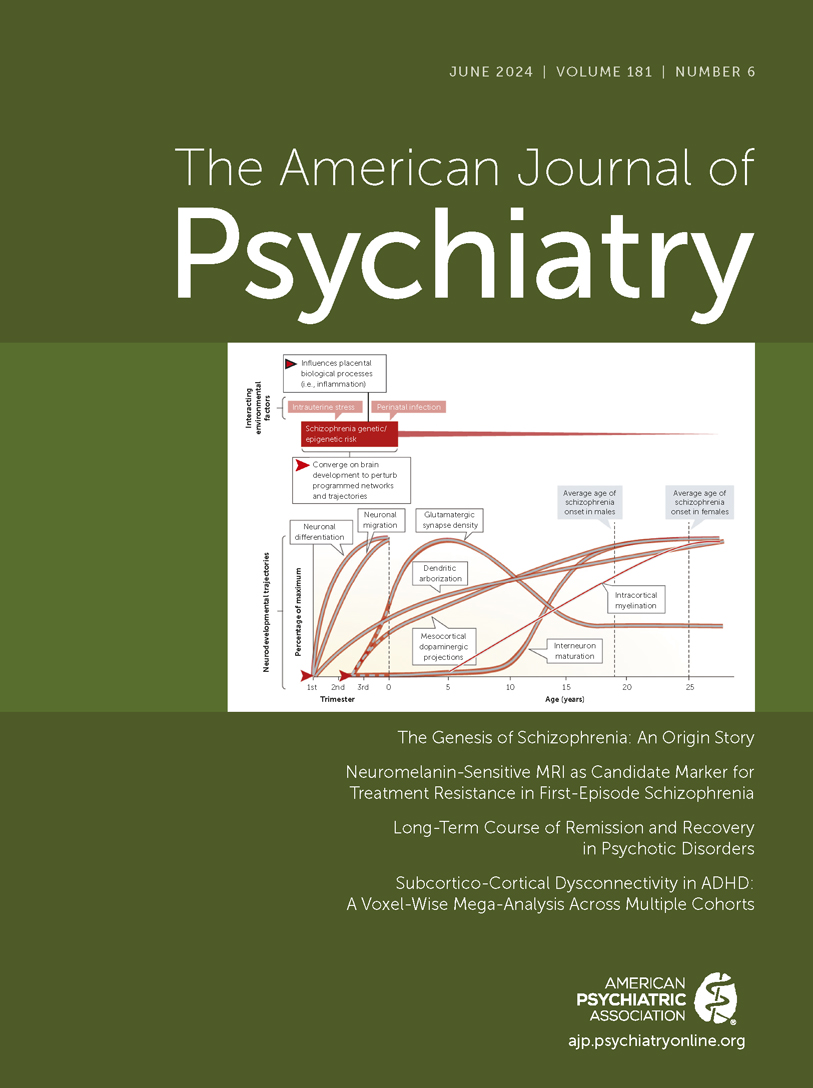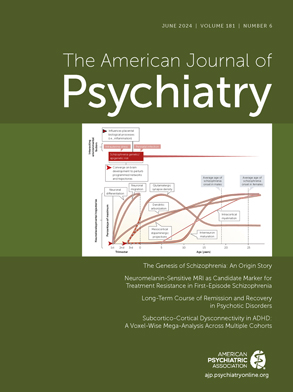The past three decades of structural and functional MRI (fMRI) studies have contributed to the current view that attention deficit hyperactivity disorder (ADHD) is a neurodevelopmental disorder, characterized by differences in the underlying brain structure, function, and structural and functional connectivity (
1,
2). The most consistently found brain differences are in frontal, temporal, parietal, and striatal regions or networks that mediate higher-level attention and cognitive control functions that are often impaired in ADHD (
1–
4). More recently, in large-scale MRI mega- and meta-analyses (
3,
4), affective regions such as amygdala and associated fronto-limbic regions have also been found to be different in structure, parallel to the increased awareness of affective behavior traits in the disorder, such as emotional dysregulation mediated by these areas (
1). A key flaw of MRI studies in ADHD, as in other psychiatric disorders, is the inclusion of small numbers of participants, which has likely contaminated the field with false positives and inflated the effect sizes of nonreproducible brain differences (
5,
6). This applies, in particular, to the majority of functional connectivity fMRI studies in ADHD, which have had small samples and highly heterogeneous analytical methods, resulting in inconsistent and likely inflated findings with respect to location and direction of network differences, such as increased, decreased, or no differing resting-state and task-based functional connectivity in participants with ADHD (
7–
9). This problem is addressed by Norman et al. in this issue of
Journal (
10), in a much-needed large-scale mega-analysis of resting-state functional connectivity data in 8,442 participants with and without ADHD, collected across multiple centers in the United States.
The inclusion of very small numbers of participants, in addition to relatively homogeneous, predominantly male groups without comorbid conditions, has likely inflated the imaging findings in ADHD and led to false positives that are not reproducible. Indeed, observed differences in brain measures between case and control subjects appear to become progressively smaller with larger and more inclusive and heterogeneous samples. A good example of this is in the largest structural MRI mega-analyses of the ENIGMA ADHD group, including more than 2,200 participants with ADHD and a similar number of control subjects, across 36 centers, which showed consistent but very small differences (about 1%–2.5%) in structural measures, and in children with ADHD only, with small effect sizes (Hedges’ g ranging from −0.1 to −0.21) (
3,
4).
A strength of Norman and colleagues’ cross-center mega-analysis of resting-state functional connectivity data is the large sample size, which included 1,705 youths with ADHD and 6,737 unaffected control subjects, as well as the trait association analysis across 9,890 individuals, using six mostly multisite data sets across the United States (with the Adolescent Brain Cognitive Development data set alone being a 21-site pediatric cohort). The study found that youths with ADHD showed increased resting-state functional connectivity between striatal seeds and inferior fronto-insular, superior temporal, inferior parietal, and supplementary motor regions as well as between the amygdala and the dorsal anterior cingulate/medial frontal cortex, with the most robust findings for the caudate seed. The findings were similar in the dimensional analysis for associations with the attention problems subscale of the Child Behavior Checklist. Furthermore, the findings were robust, as they remained significant in sensitivity analyses that controlled for typical confounders in ADHD, such as common comorbid internalizing and externalizing conditions, IQ, and motion artifacts. As in the structural differences in these regions (
3,
4,
11), the functional connectivity differences were also not related to medication use, as the findings remained significant in the 1,123 stimulant-free youths with ADHD, albeit at a more relaxed significance threshold. Furthermore, the association findings were specific to the attention problem scores and not to the internalizing and externalizing problem subscores. Also, parallel to similarly large-sampled structural and diffusion tensor imaging (DTI) mega-analyses across centers (
3,
4,
11,
12), the differences were small, with the largest effect sizes being a Cohen’s d of 0.15 for the diagnostic analysis and a partial r of 0.07 for the dimensional analysis. Surprisingly, the findings were not related to any ADHD-relevant neuropsychological functions tested in the study (attention, interference inhibition, working memory, processing speed).
The Norman et al. study is the largest and most representative functional connectivity mega-analysis in ADHD to date. The findings extend the evidence for small but consistent fronto-striatal abnormalities in ADHD based on structural (
3,
4) and task-based functional MRI findings (
13–
15) to the functional network level. Dysfunction in inferior fronto-striatal activation is the most consistently replicated finding of the task-based fMRI literature in ADHD (
13–
15), with the latest and largest meta-analysis of fMRI studies of cognitive control including 1,533 ADHD patients (
15). The dimensional associations of connectivity differences with attention traits are parallel to the associations between ADHD traits in the general population and structural MRI and DTI differences (
4,
12) and reinforce the notion of ADHD as the extreme, more immature end of behavioral traits in the population that have been shown to be associated with a delay in brain maturation and that diminish naturally with age (
1,
2). The disorder specificity of the functional connectivity associations with attention problems relative to other internalizing and externalizing traits extends the meta-analytic fMRI evidence of specificity of task-based inferior fronto-striatal functional activation differences relative to patients with obsessive-compulsive disorder (
14) and autism (
15).
The finding of increased functional connectivity between the amygdala and the anterior cingulate/medial frontal cortex is likely related to affective behavioral abnormalities in the disorder, such as emotional dysregulation, and extends findings of abnormalities in the amygdala and anterior cingulate in larger-scale structural MRI studies (
3,
4,
12), where they were associated with abnormal development and ADHD severity (
12), and may be related to DTI differences in the uncinate fasciculus, which connects the amygdala-temporal and frontal regions responsible for emotion processing (
11).
The lack of association with cognitive performance is intriguing. However, the inferior fronto/insular–supplementary motor area–caudate dysconnectivity is likely more related to motor inhibitory control mediated by these regions (
13–
15), which was not included in the task battery, than it is to the cognitive functions measured (interference inhibition, attention, processing speed, or working memory), which are mediated by more dorsal fronto-parietal networks. Likewise, no task was included that measured affective processes mediated by amygdala-cingulate connectivity.
The increased resting-state functional dysconnectivity of inferior fronto-insular, parieto-temporo-striatal, and amygdala-cingulate networks largely overlaps with network hubs of task-based functional connectivity differences (
8). However, both increased and decreased connectivity have been found in these hubs for task-based analyses, likely as a result of small samples (with the average sample size being 28 participants) and heterogeneous analytic methods (
5).
“Big data” mega-analyses of imaging data of ADHD, collected across many centers, have the advantage of inclusivity, representativeness, generalizability, reproducibility, and clinical utility as well as allowing for dimensional analyses that go beyond narrow diagnostic case-control analyses. However, some of these advantages are also disadvantages; inclusivity and generalizability, for example, increase heterogeneity. A limitation of the study, as with all multicenter mega-analyses, is hence the reliance on legacy data with large phenotypical heterogeneity, including in demographic, clinical, cognitive, scanner, and imaging protocol characteristics, which may deflate or obscure the effect sizes of real differences that might be observed in more homogeneous phenotypes. Furthermore, the observational and cross-sectional nature of the data does now allow any insights into directional effects or causal inferences. Last, recent evidence suggests that complex behavior traits such as ADHD may be best explained by cumulative effects across most resting-state functional brain networks rather than by testing specific individual networks (
6).
To thoroughly understand the neurobiological underpinnings of ADHD, we need complementary data sets, including large-scale, international, cross-center mega-analyses, like the study by Norman et al., as well as large prospective multisite studies of homogeneous phenotypes (such as specific age groups, ADHD presentations, or comorbid conditions) tested in harmonized protocols, alongside dimensional approaches and large-sample prospective longitudinal data sets, including genetic, environmental, and cognitive data, to better understand lifespan trajectories and allow for causal inferences. Finding consistent brain biomarkers for ADHD and understanding what causes them to develop will be paramount in developing targeted remediation, be it with pharmacotherapy, sociobehavioral treatments, or neurotherapeutics.

